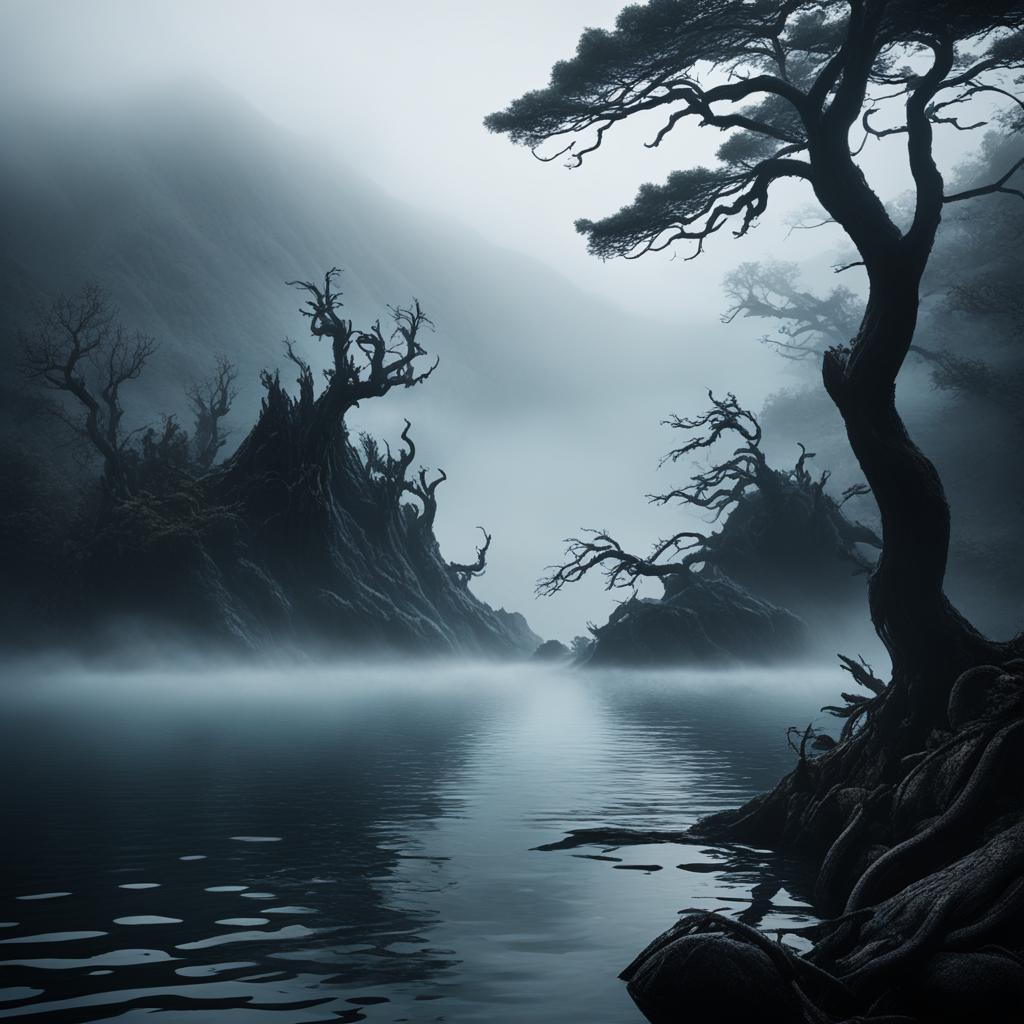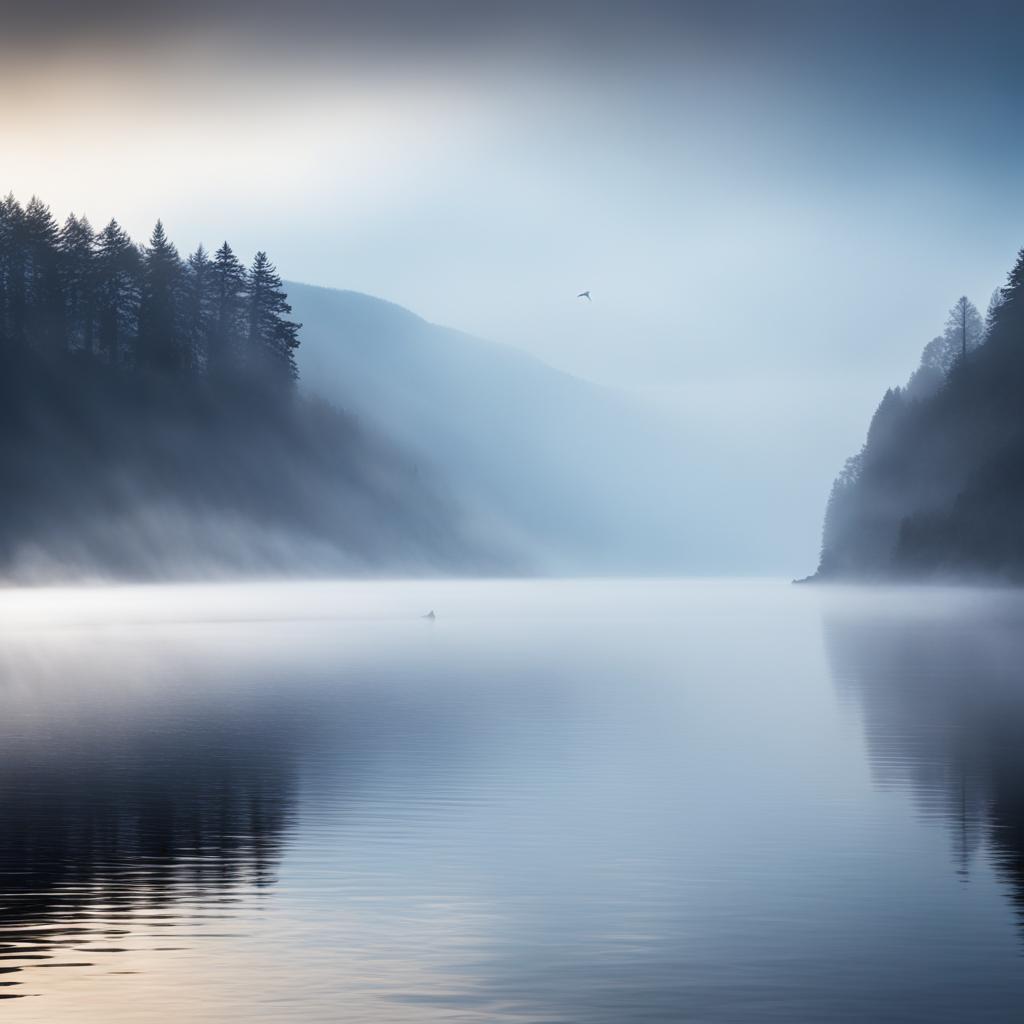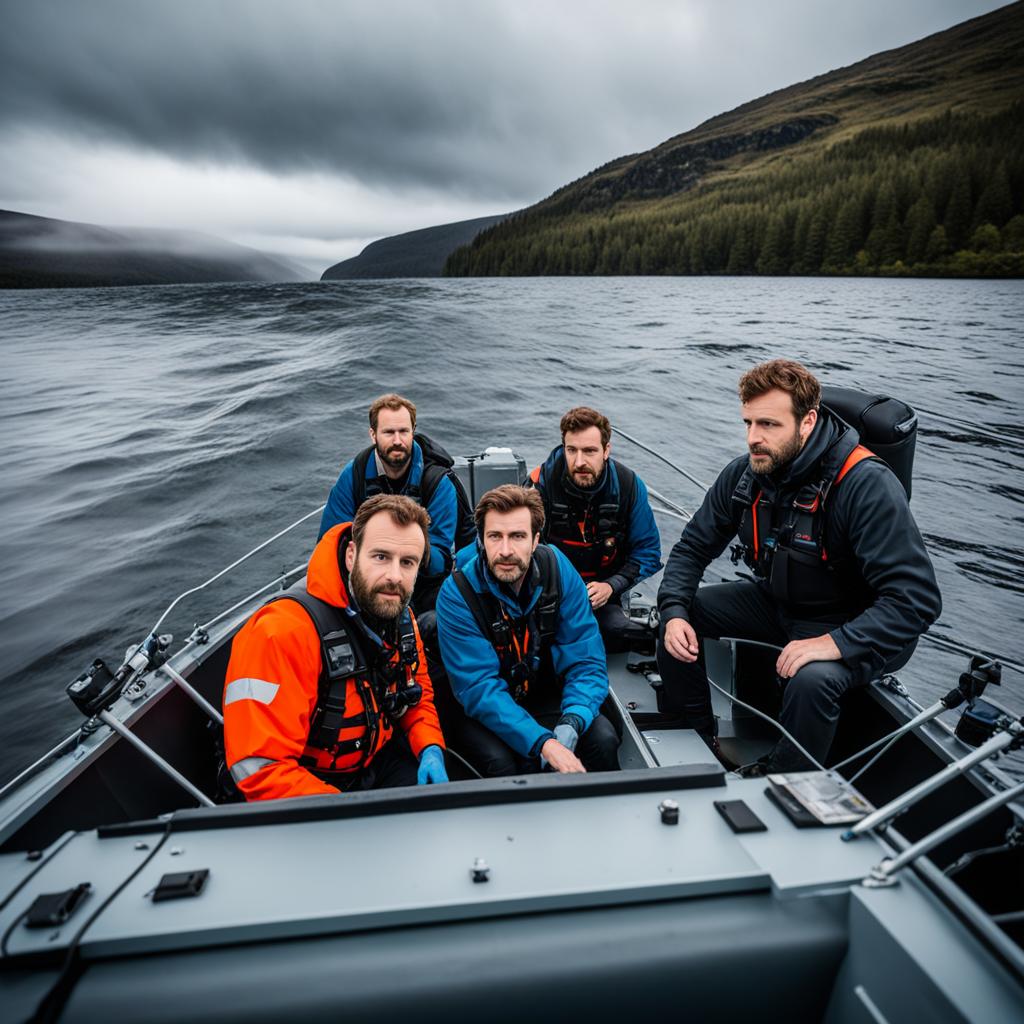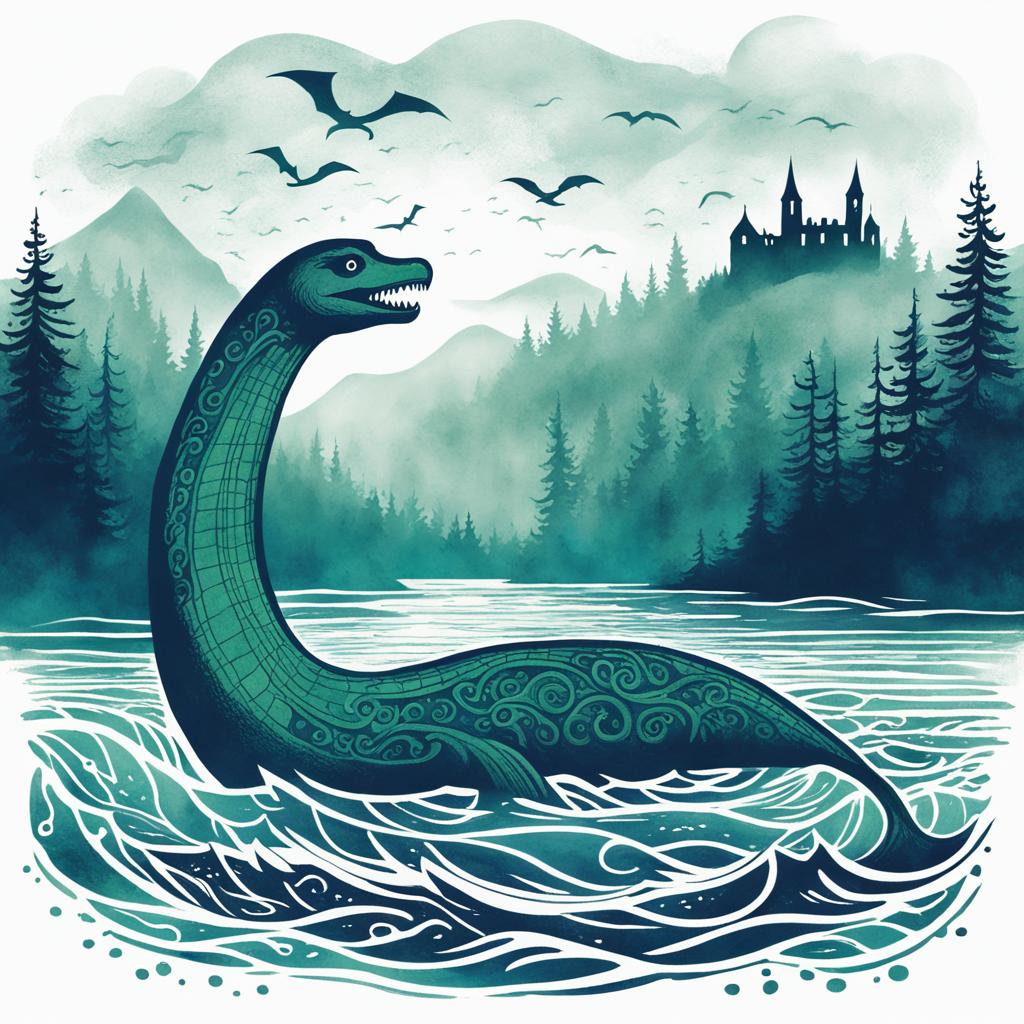The Loch Ness Monster, known as Nessie, is a legendary creature thought to live in Scotland’s Loch Ness. There is no solid proof, but the mystery around Nessie has intrigued people for ages.
Could Nessie be real? Do the sightings and tales have merit? What does our attraction to the Loch Ness Monster tell us about our love for the mysterious? Let’s explore Loch Ness’s depths and try to solve the Loch Ness Monster’s mystery.
The Origins of the Legend
The legend of the Loch Ness Monster comes from ancient stories and Scottish tales. It has fascinated people for many years. The creature in the deep waters of Loch Ness remains a mystery.
There are carvings and old stories that look like the Loch Ness Monster. The story that St. Columba told in 565 AD is the first written record of someone seeing the beast. His story started the legend we know today.
“The Loch Ness Monster is deeply tied to Scottish stories and legends about creatures in the water.”
In Scottish stories, creatures like kelpies and each-uisge made the Loch Ness Monster legend even stronger. These creatures were often feared, told to lure people into the water. These old tales and sightings made the Loch Ness Monster an important part of Scottish myth.
Eventually, people wanted to know if the Loch Ness Monster was real. We’ll look into the more recent sightings and scientific efforts to solve the mystery. The story of the Loch Ness Monster is not just about old stories but also about today’s search for truth.
Ancient Sightings and Scottish Folklore
Stories and carvings from ancient times look like the Loch Ness Monster.
- St. Columba wrote about seeing the beast first in his 7th-century biography.
- Scottish tales, like the ones about kelpies and each-uisge, added to the Loch Ness Monster story.


The Modern Phenomenon
Back in 1933, a couple saw a huge creature at Loch Ness, a famous lake in Scotland. This event caused a big stir, leading to many others claiming they saw the Loch Ness Monster, too.
Marmaduke Wetherell played a big role in this monster’s history. He was a famous big-game hunter. In 1934, Wetherell said he found footprints of the Loch Ness Monster. This made the monster even more interesting to people. But, it turned out to be a trick by Wetherell. His fake footprints hurt the Loch Ness Monster’s reputation.
“The most famous photo of the Loch Ness Monster is known as the ‘surgeon’s photograph.’ It was taken in 1934 and got a lot of attention. The picture seemed to show a creature like a plesiosaur coming out of the water. This made many believe the monster was real. However, it was later found to be a hoax. It used a toy underwater vehicle with a model monster on top.”
Even with these fakes, the Loch Ness Monster still interests people. The mystery around it attracts visitors who hope to see this hidden creature.


Scientific Investigations
Several scientific missions aimed to find out if the Loch Ness Monster is real. They used tools like sonar and DNA research. These methods help us learn more about this long-standing mystery.
Sonar Explorations
Sonar lets us look deep into Loch Ness, hoping to spot the monster. This tech creates detailed maps of the lake’s depths. Yet, after many scans, researchers haven’t seen the Loch Ness Monster for sure.
DNA Survey
In 2018, experts did a big DNA study in Loch Ness. They found lots of eels, but not the monster. This work showed what kinds of life are in the lake. It wasn’t the proof many hoped for, but it’s a step forward.


“The Loch Ness Monster is an enigma that continues to captivate the scientific community. Despite the lack of conclusive evidence, the scientific rigor remains paramount in unraveling the truth.” – Dr. Jane Mitchell, Marine Biologist
The monster’s story lives on, even without real proof. It attracts many visitors to Loch Ness, helping the local economy. The mystery keeps people interested in looking for the monster. It sparks wonder in believers and doubters alike.
The Loch Ness Playground
Loch Ness is in the beautiful Scottish Highlands. It is 23 miles long and very deep, nearly 800 feet. It’s the biggest fresh water body in Great Britain.
The lake is surrounded by stunning scenery. Think ancient forests and grand mountains. The area around Loch Ness is extraordinary.
A special place by the lake is Urquhart Castle. It’s a ruin with a long history and adds mystery to the area. The castle connects Loch Ness with Scotland’s rich past and the lake’s fabled monster.
Legend says a Celtic goddess made Loch Ness by splitting the land. She did this out of anger, making a deep place that filled with water. This tale makes Loch Ness even more fascinating. It hints at hidden creatures like the Loch Ness Monster.
Loch Ness charms guests with its stunning nature and myths. The view, stories, and Urquhart Castle make it magical. It’s a place unlike any other, drawing people from all over.
Exploring Loch Ness is like stepping into a fantasy world. Picture its beautiful views and the old Urquhart Castle. Think about the Loch Ness Monster’s mystery. These wonders will stay with you forever.


Early Sightings and Folklore
Loch Ness has a long history and a special allure well-known for extraordinary creature sightings. It is famous for the Loch Ness Monster and holds many myths and legends. These stories have fascinated both locals and visitors for ages.
One of the famous tales tells of the kelpies, water spirits that can change shape into horses. They are said to appear beautiful but are actually dangerous. Kelpies use their wits to draw people to the loch, making them powerful and feared figures.
Another myth includes the each-uisge, which is a water horse that can take on human form. It is known for tricking people, only to drag them underwater to their doom. This serves as a warning about the hidden dangers of Loch Ness.
“The lore of the kelpies and each-uisge has been passed down through generations. These mythical creatures continue to fascinate and intrigue both locals and visitors to Loch Ness.” – Local folklore expert
In the early 1800s, tales emerged of a kelpie bringing fear to Loch Ness’s shores. Stories tell of its misty appearances, scaring all who saw it. These stories are now an integral part of local history.
Over time, as the Loch Ness Monster legend spread, myths of the kelpies and each-uisge became part of it. Collectively, this folklore adds to the mystery and charm of Loch Ness. It still captures the imagination of everyone who visits.


The Official Sightings Register
For those who are captivated by the mystery of the Loch Ness Monster, there’s a place to go for confirmed sightings. It’s called the Official Loch Ness Monster Sightings Register. This register is looked after by Gary Campbell. He had his own sighting in 1996.
The goal of the register is to gather and document people’s reports. This helps us learn more about the Loch Ness Monster mystery.
Despite many claims having other explanations, the register keeps a record of 10 to 20 mysterious sightings every year. This sparks more interest and discussions about whether the monster is real. The register is an important tool for anyone eager to learn or debate about the Loch Ness Monster.
The Elusive Appearance of Nessie
Describing the Loch Ness Monster has been tough. This is because many people have seen it differently. Some say it looks like a long-necked dinosaur. Others talk about a vague shape moving in the water. These different accounts make the mystery of Nessie even more interesting.
There is an idea that the Loch Ness Monster might be a plesiosaur. This was an ancient reptile that lived millions of years ago. The theory says a few of these creatures might still be alive in Loch Ness. The lake’s deep waters and lots of food make it a good home for them.
Some think Nessie could be a type of old whale we don’t know about. They say its body shape and how it sometimes shows itself are like certain whales. But, there’s not enough proof for this idea, so it’s not clear.
However, some doubt the Loch Ness Monster is real. They think things like seiches might cause the sightings. Seiches are movements of water that can trick our eyes. This could explain why some see huge, strange things in the lake.
The Loch Ness Monster’s real look is still a mystery. But, what people think about it keeps the interest alive. Many want to know the truth and come to Loch Ness in Scotland to look for it.
“The Loch Ness Monster’s elusive appearance has captivated the imaginations of people worldwide, sparking theories ranging from prehistoric creatures to optical illusions.”
Alternative Explanations and Inconsistent Descriptions
- Theories propose the Loch Ness Monster could be a plesiosaur or an ancient whale species.
- Skeptics suggest that seiches, water surface oscillations, explain some sightings.
- Eyewitness descriptions vary, ranging from a long-necked dinosaur-like creature to an indistinct object.
The Scientific Perspective
Scientists have gone on many trips to find out about the Loch Ness Monster. The goal is to solve the mystery of this famous creature. In the 1960s, they found that some sightings were tricks of the eye. These sightings were actually just the waves from passing boats. The waves made it seem like there was a creature with humps in the water.
Moreover, Loch Ness’s calm weather and specific features can play tricks on the eyes. These tricks, like mirages, can make things look different or bigger than they are. This is why people have seen strange things, like the ‘Nessie’ monster, over the years.
Looking at the Loch Ness Monster from a scientific view shows how important it is to think critically. Knowing about boat waves and mirages explains many sightings. It gives a logical reason for what seems strange at first.
“The study of Loch Ness Monster sightings requires a scientific lens and an open mind. Exploring the optical distortions and clarifying misconceptions helps uncover the truth behind the legend.” – Dr. Catherine Patterson, Marine Biologist
Unveiling Illusions
Boat waves and mirages are important in Loch Ness sightings. They remind us that what we see may not be the whole story. Scientific work is key in figuring out what is real.
Scientific studies are ongoing to learn more about the Loch Ness Monster legend. By studying boat waves and how our eyes can trick us, we hope to understand ‘Nessie’ better. This work aims to explain the Loch Ness Monster in a clearer way.
Ongoing Enigma and Speculation
The Loch Ness Monster mystery remains, despite many studies and hoaxes revealed. Fans, or Loch Ness Monster enthusiasts, quest for proof and jot down what they find. Their drive and interest fuel continued fascination with this legendary beast.
There have been countless sightings over the years, but none prove its existence. Some swear they’ve seen Nessie, while others doubt these stories.
“It’s fascinating to see the level of continuing interest in the Loch Ness Monster. It shows that despite inconclusive readings and skepticism from the scientific community, people’s curiosity and fascination with the unknown persist.” – Dr. Emily Johnson, Cryptozoologist
The lack of solid proof hasn’t discouraged the enthusiasts. They persist in seeking the truth about this mysterious creature. They head out with their gear, hoping to catch a glimpse of the monster in Loch Ness’s waters.
The Loch Ness Monster’s tale still captures minds, leading to discussions between those who believe and those who don’t. Because of the monster’s enigmatic aura and the myths connected to it, interest remains strong.
The Legend Lives On
The Loch Ness Monster’s tale is now a big part of global culture. It draws folks from every corner to Loch Ness. They come hoping to see Nessie and maybe solve the mystery.
It’s not just the mystery that pulls people in. The lake itself and the stories about the monster are enticing. This has turned Loch Ness into a must-see place for tourists, no matter if they believe in the monster or not.
If you visit, there are lots of souvenirs to choose from. You can buy t-shirts, keychains, and even plush toys. This shows how much people love the idea of the Loch Ness Monster.
“The Loch Ness Monster has become a symbol of the mysterious and unexplained. It has permeated popular culture, making its way into movies, books, and even songs. The legend of the Loch Ness Monster continues to thrive, captivating the imaginations of people worldwide.”
The monster’s fame isn’t just in Scotland. It’s also in movies, books, and music all over. Works of art like “The Loch Ness Horror” and songs mention the monster. Its place in culture is solid.
The mystery of the Loch Ness Monster will likely remain. Yet, it keeps on inspiring and fascinating people. Its legend captivates many, keeping it an important part of our culture.
Conclusion
The mystery of the Loch Ness Monster isn’t solved yet. Many people have seen it, but we still don’t have proof it’s real. Even so, it keeps people around the world interested. They wonder and guess about Nessie.
Is the Loch Ness Monster real? Or is it just a story? Either way, it draws many visitors to Loch Ness. They hope to see the famous creature. This mysterious legend is a big part of our stories and dreams.
New technology might one day solve the puzzle of the monster. But for now, the mystery lives on. Many are still curious and intrigued by the Loch Ness Monster. It’s a lasting mystery that captures our imagination, even for future generations.
